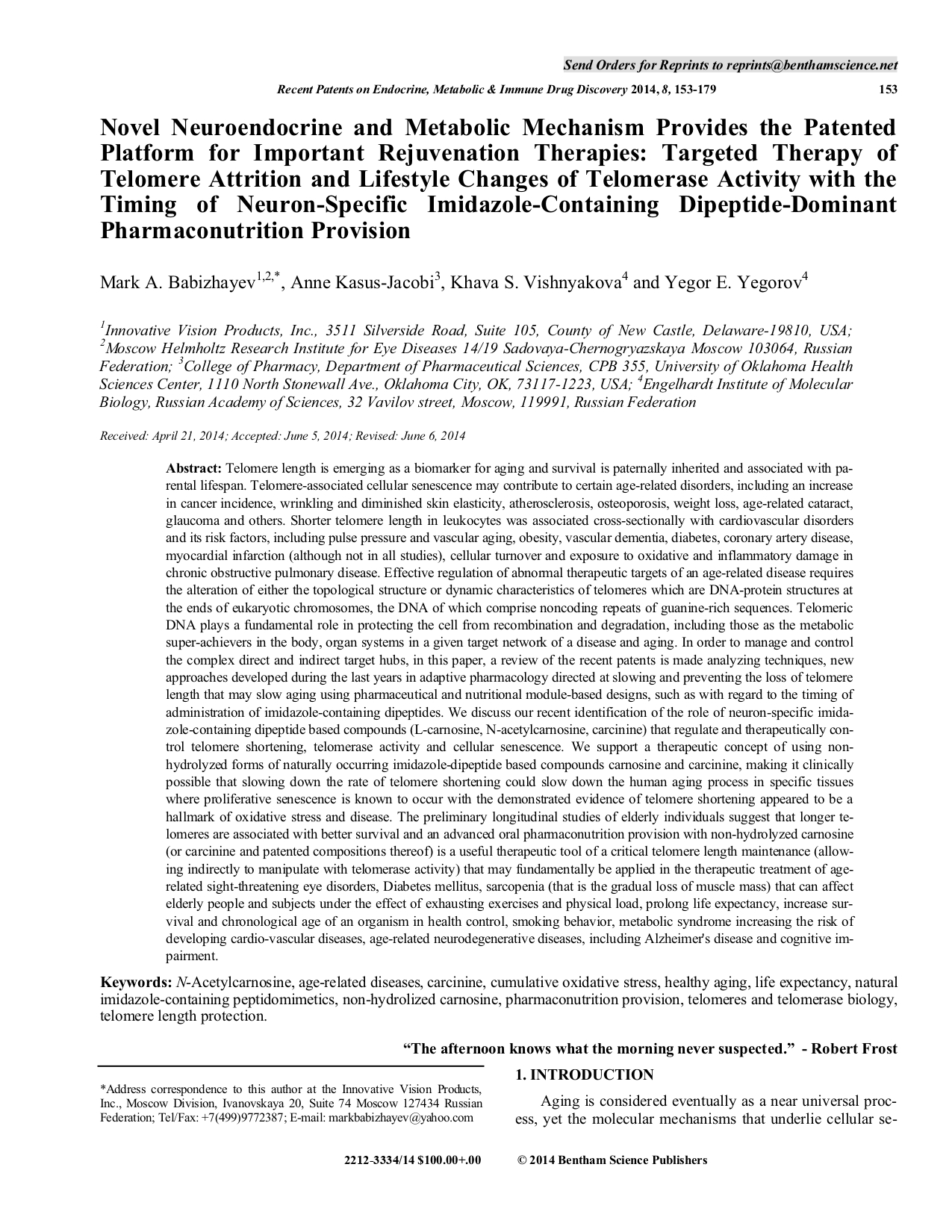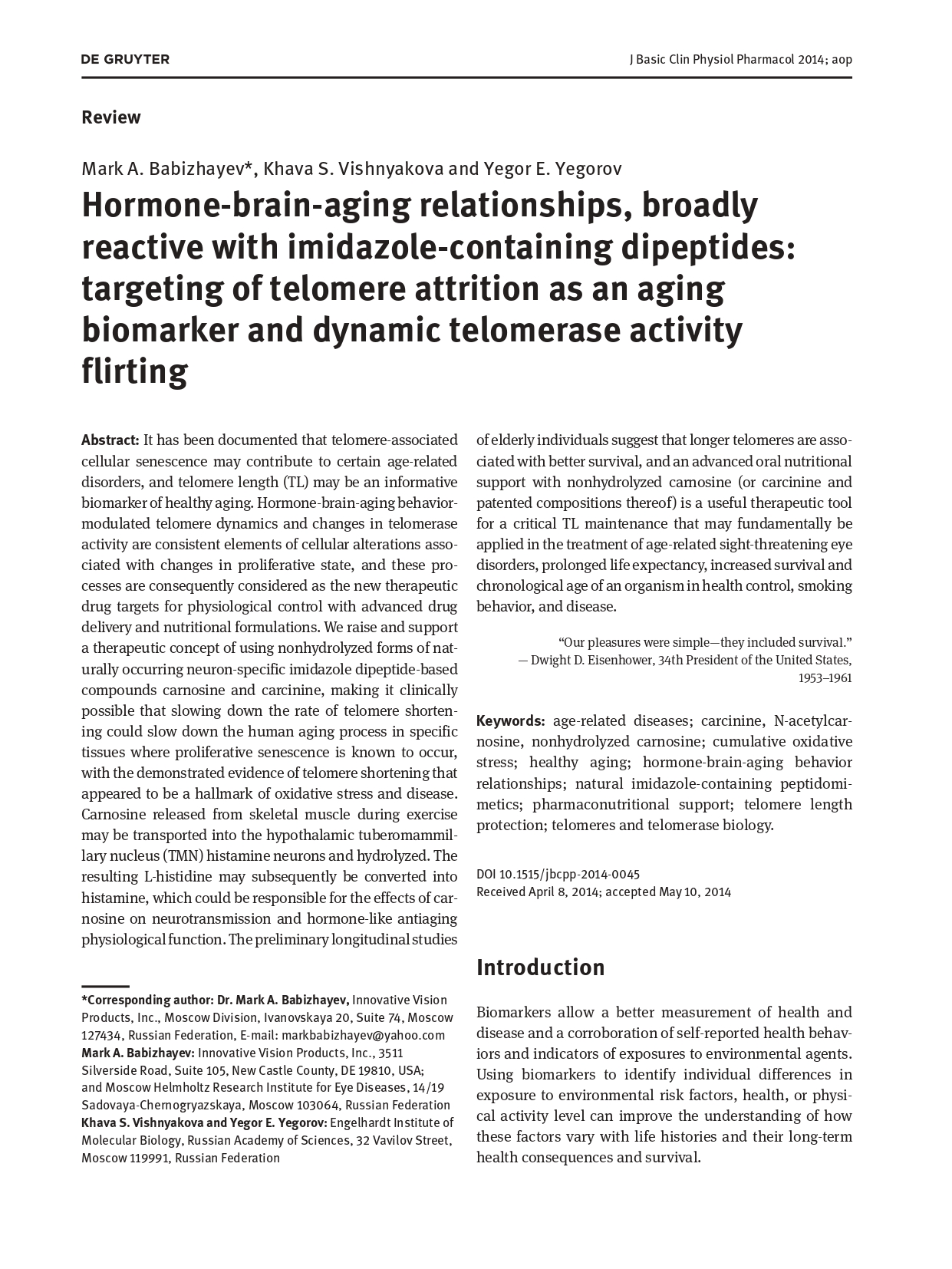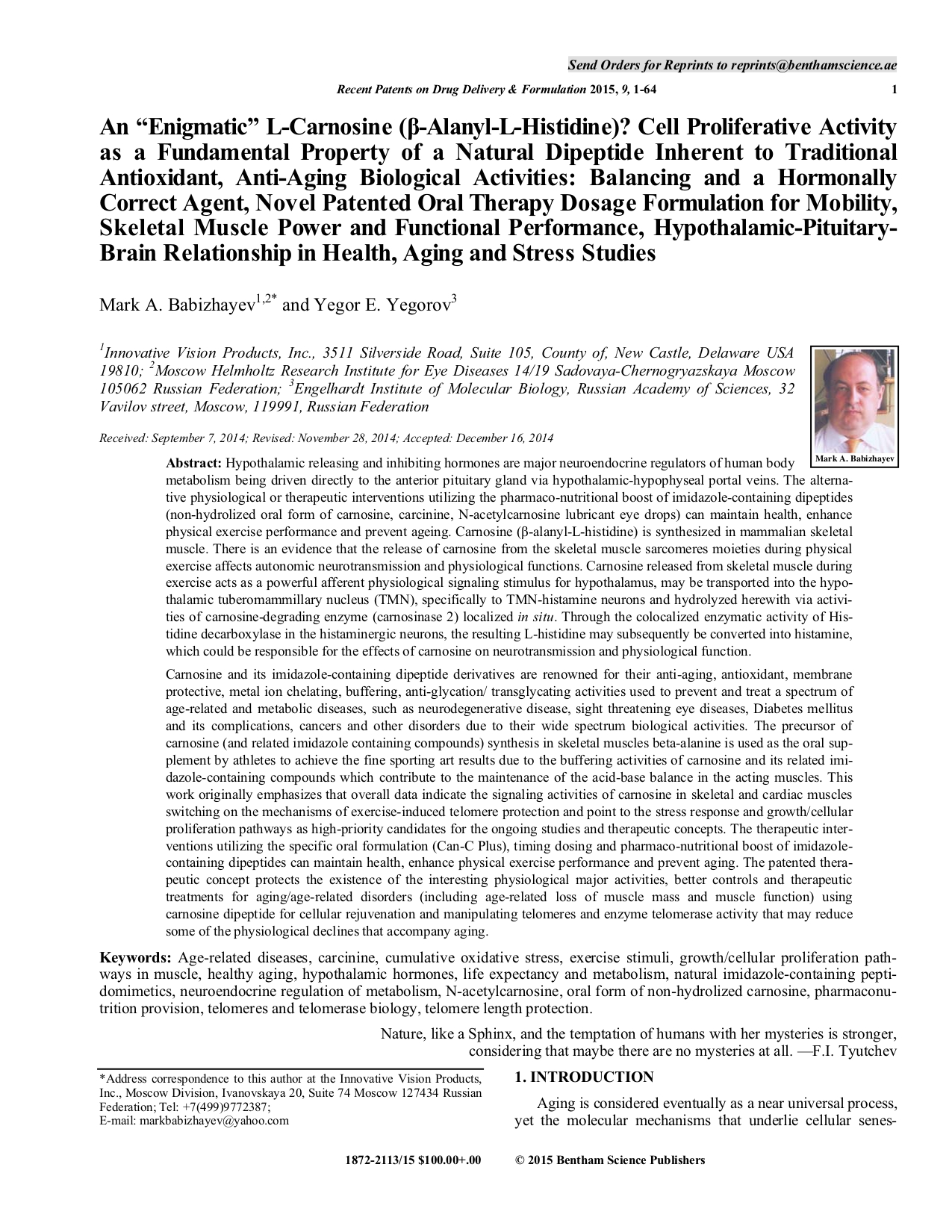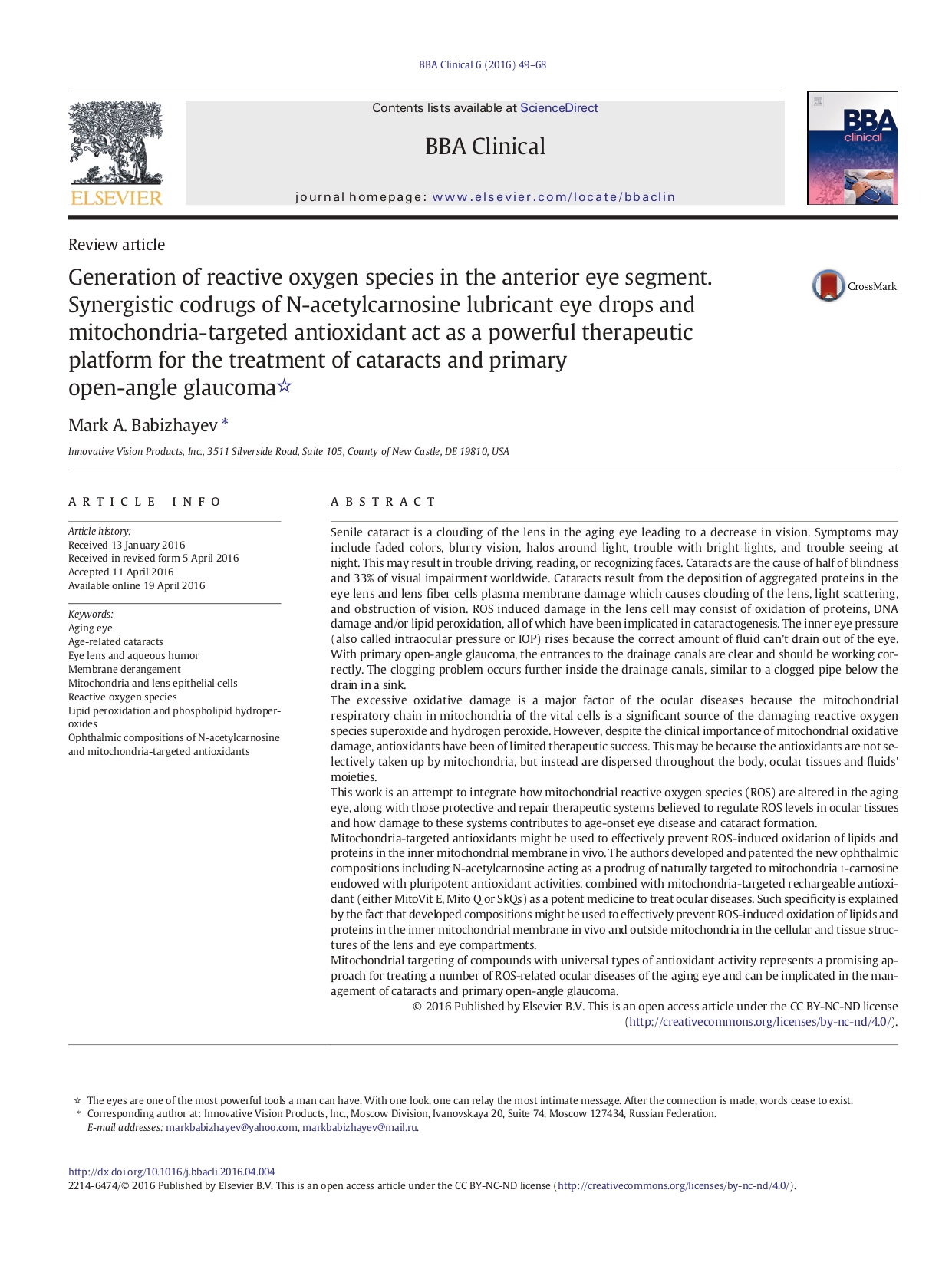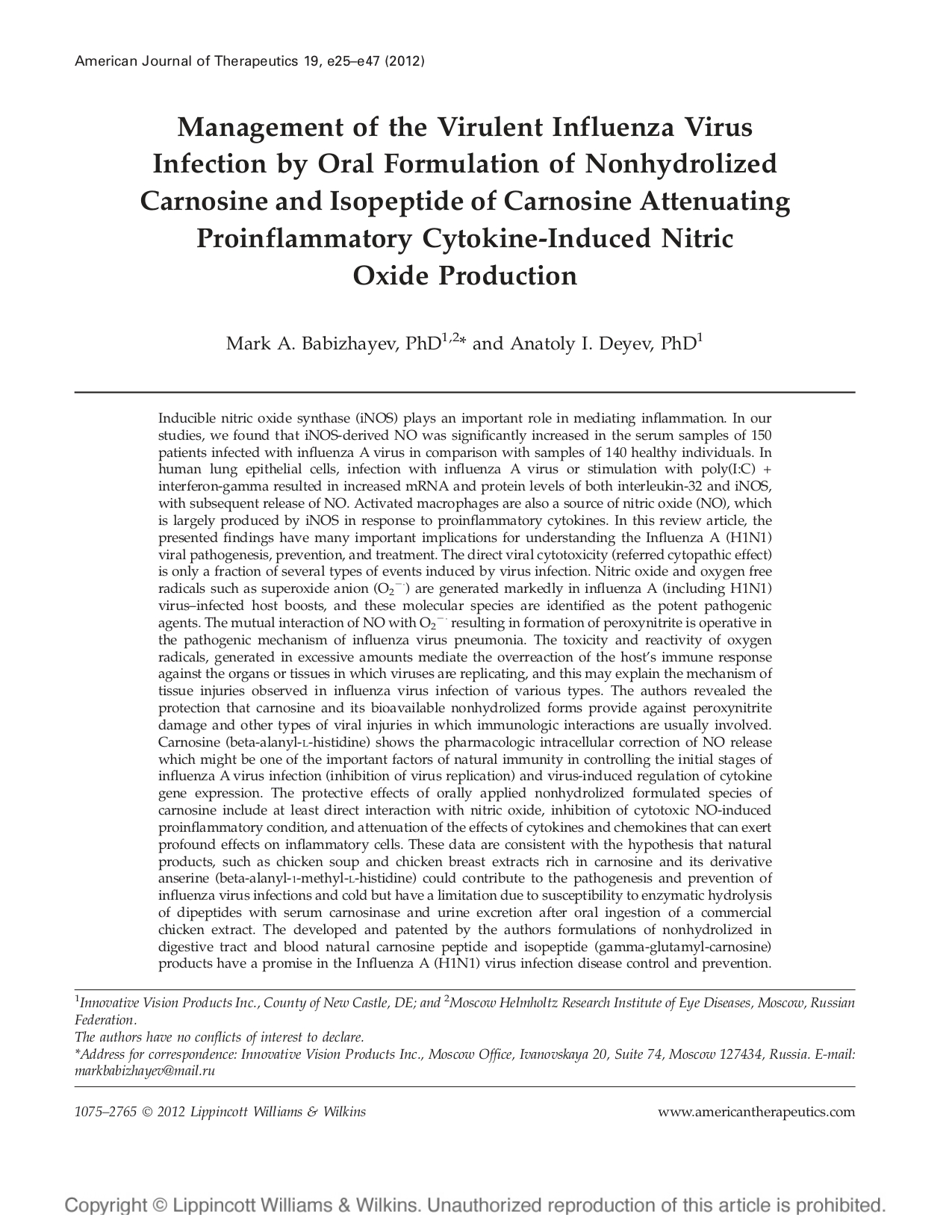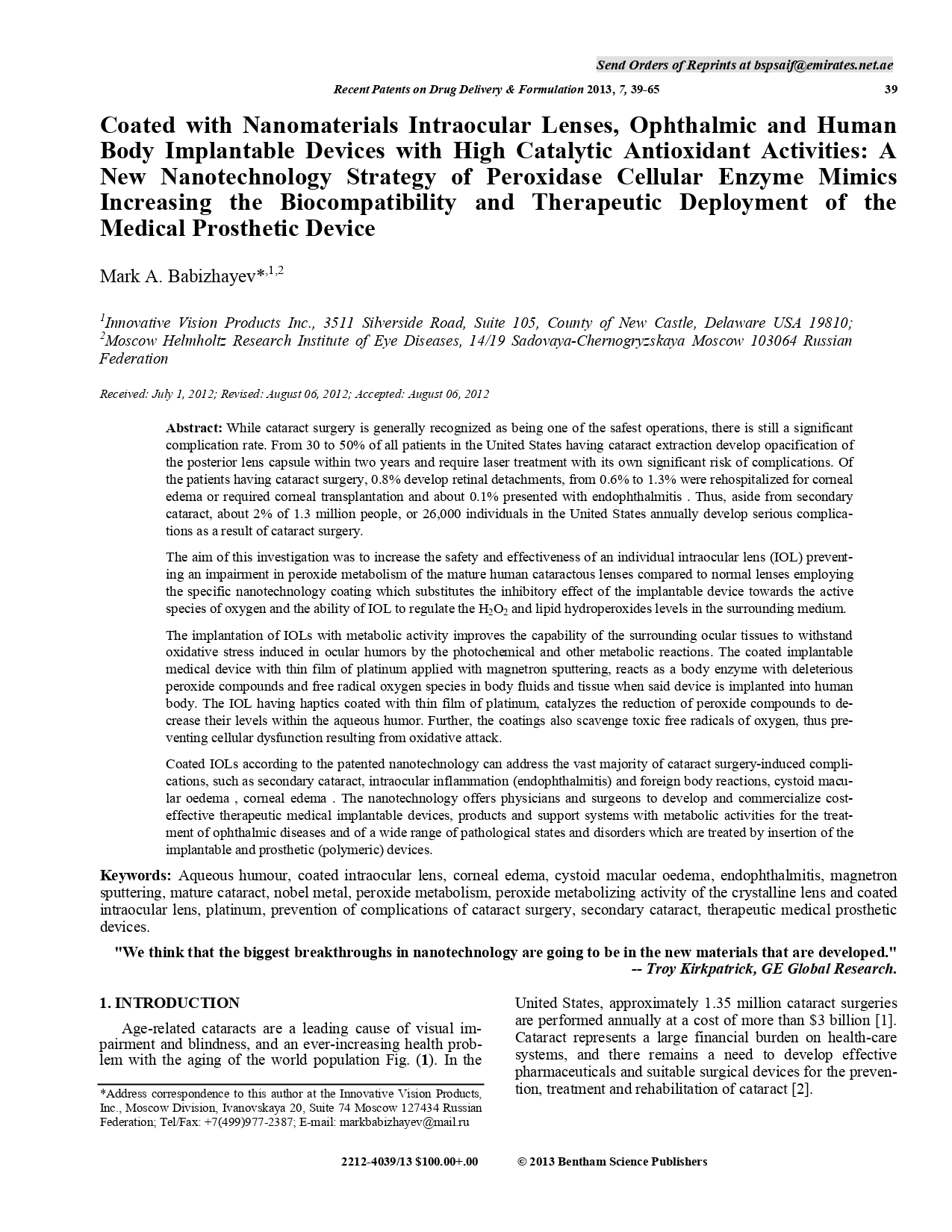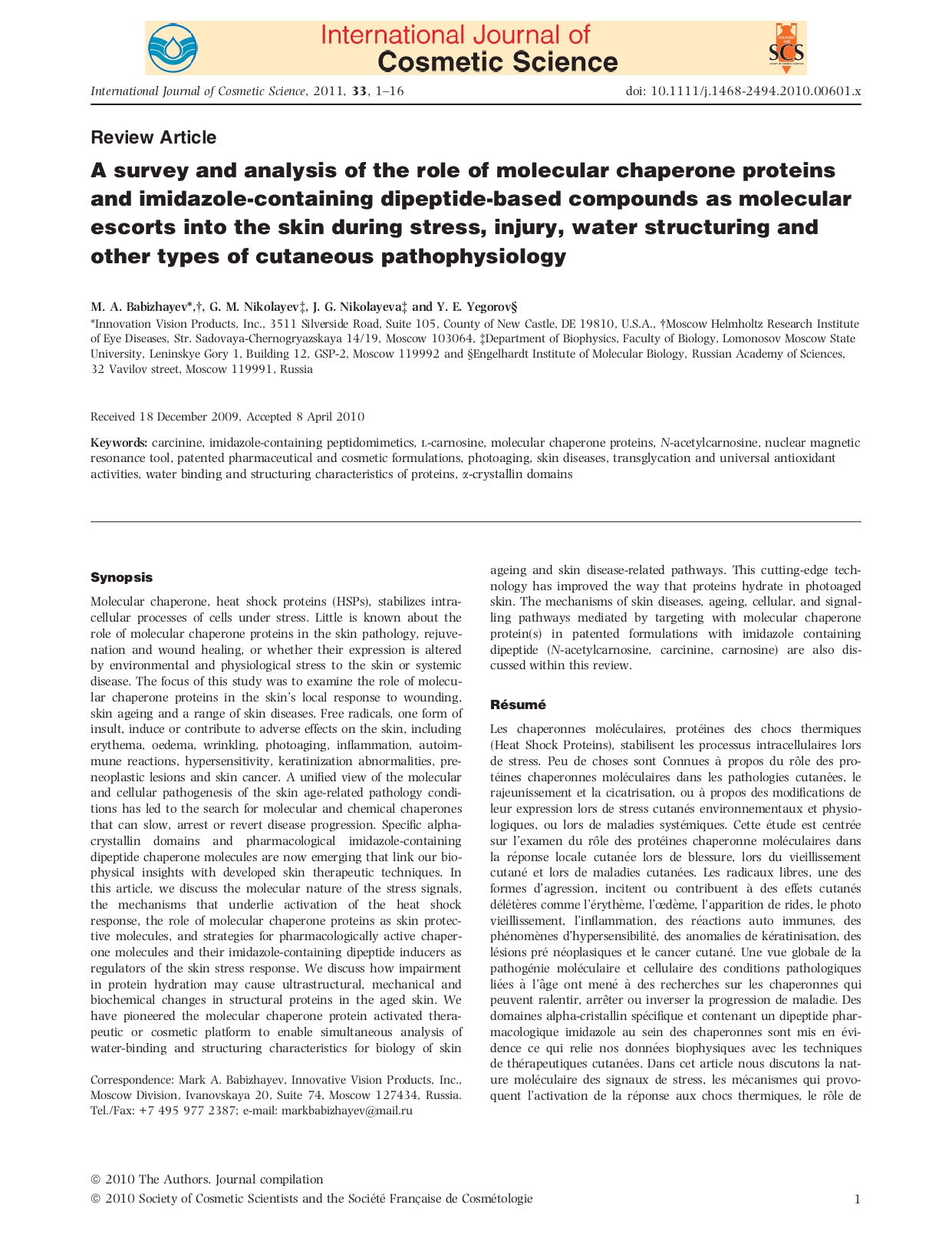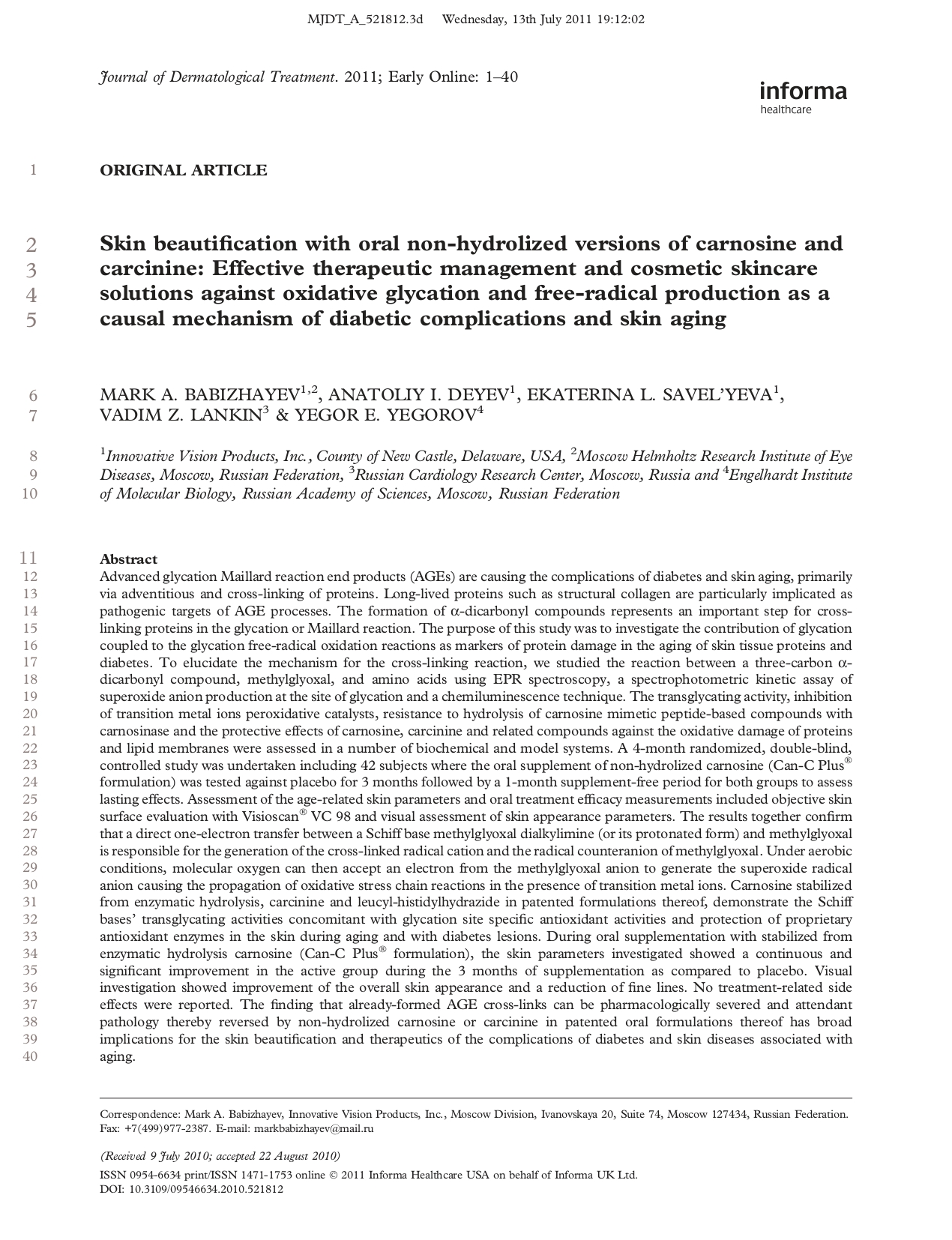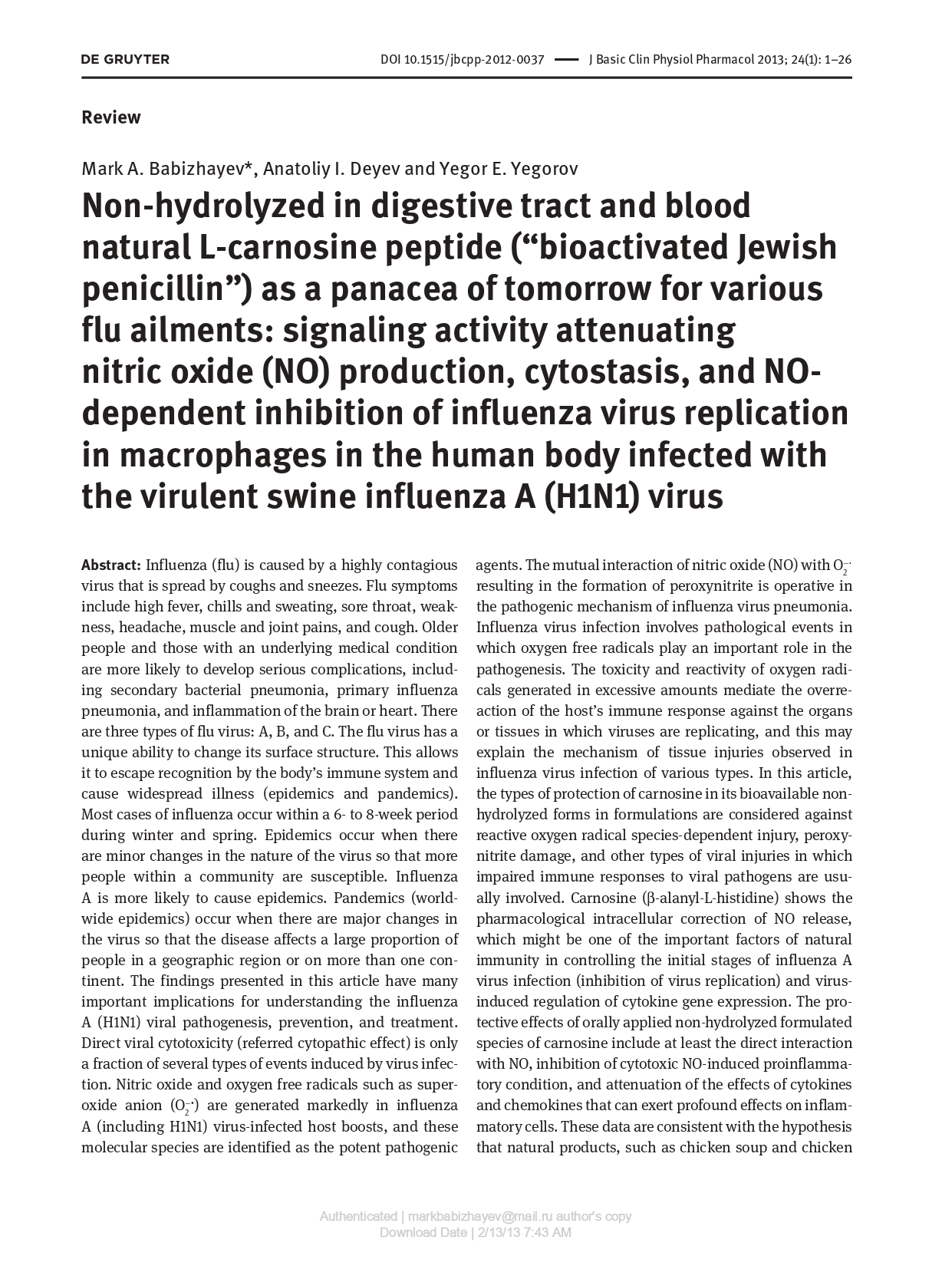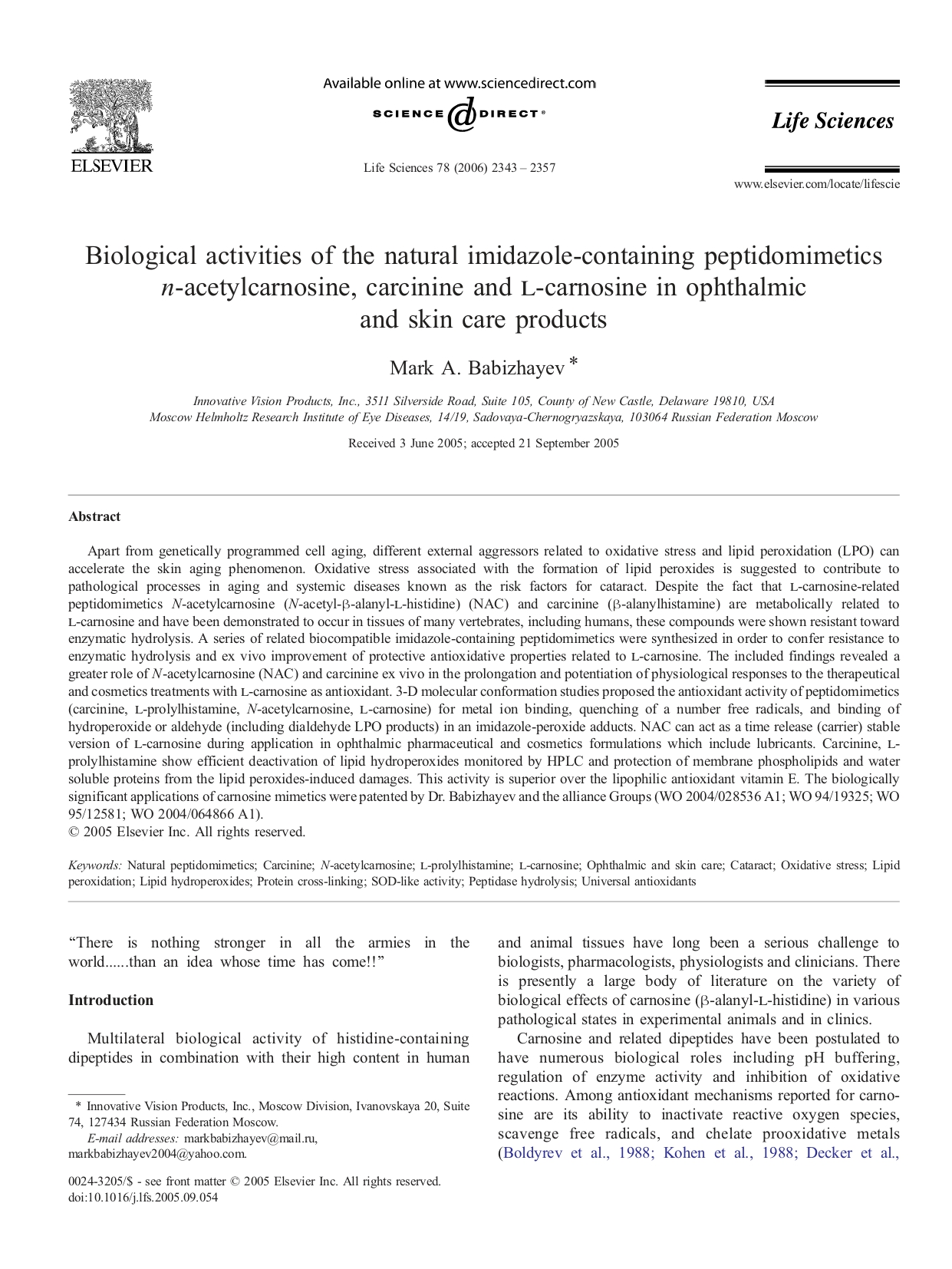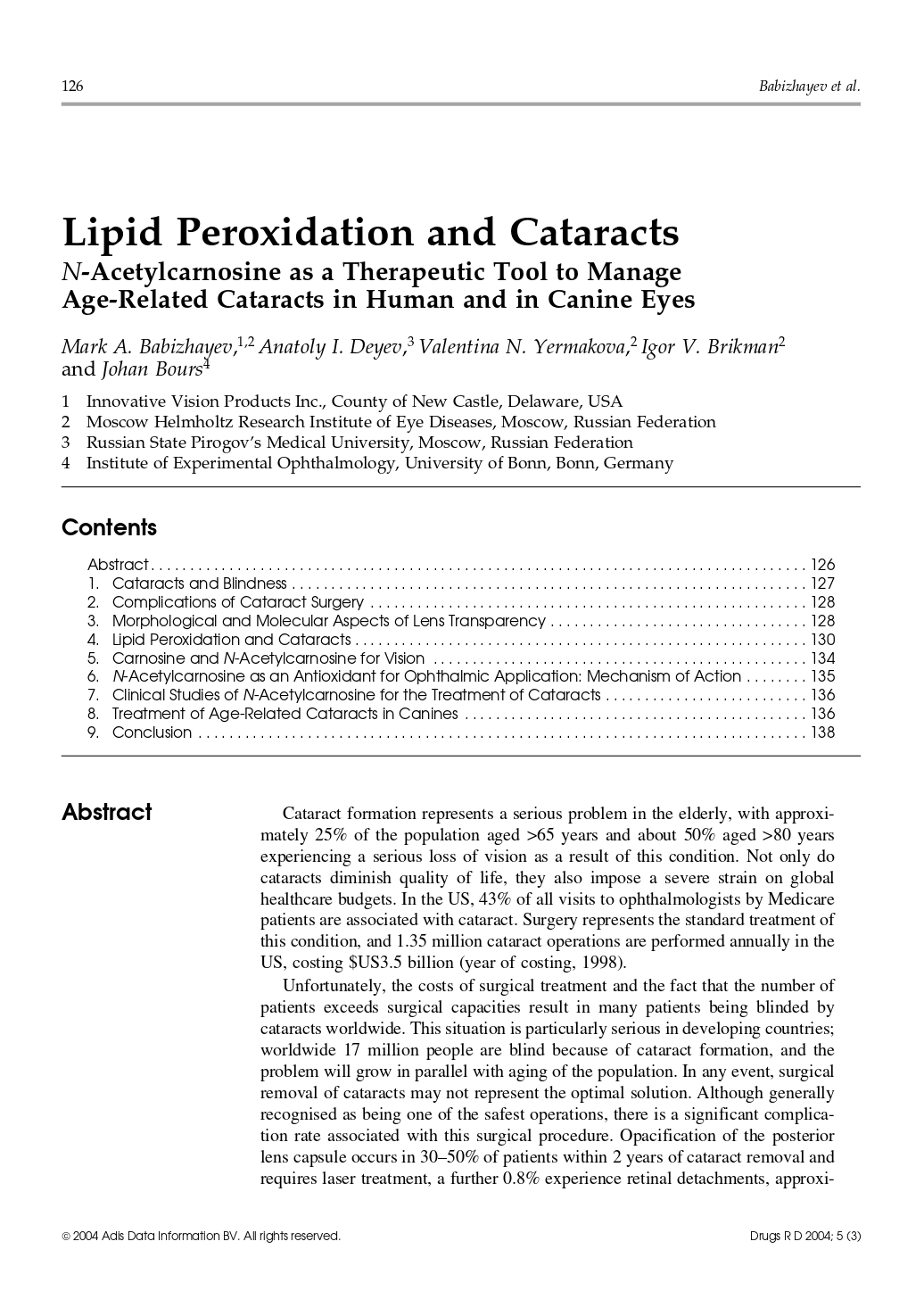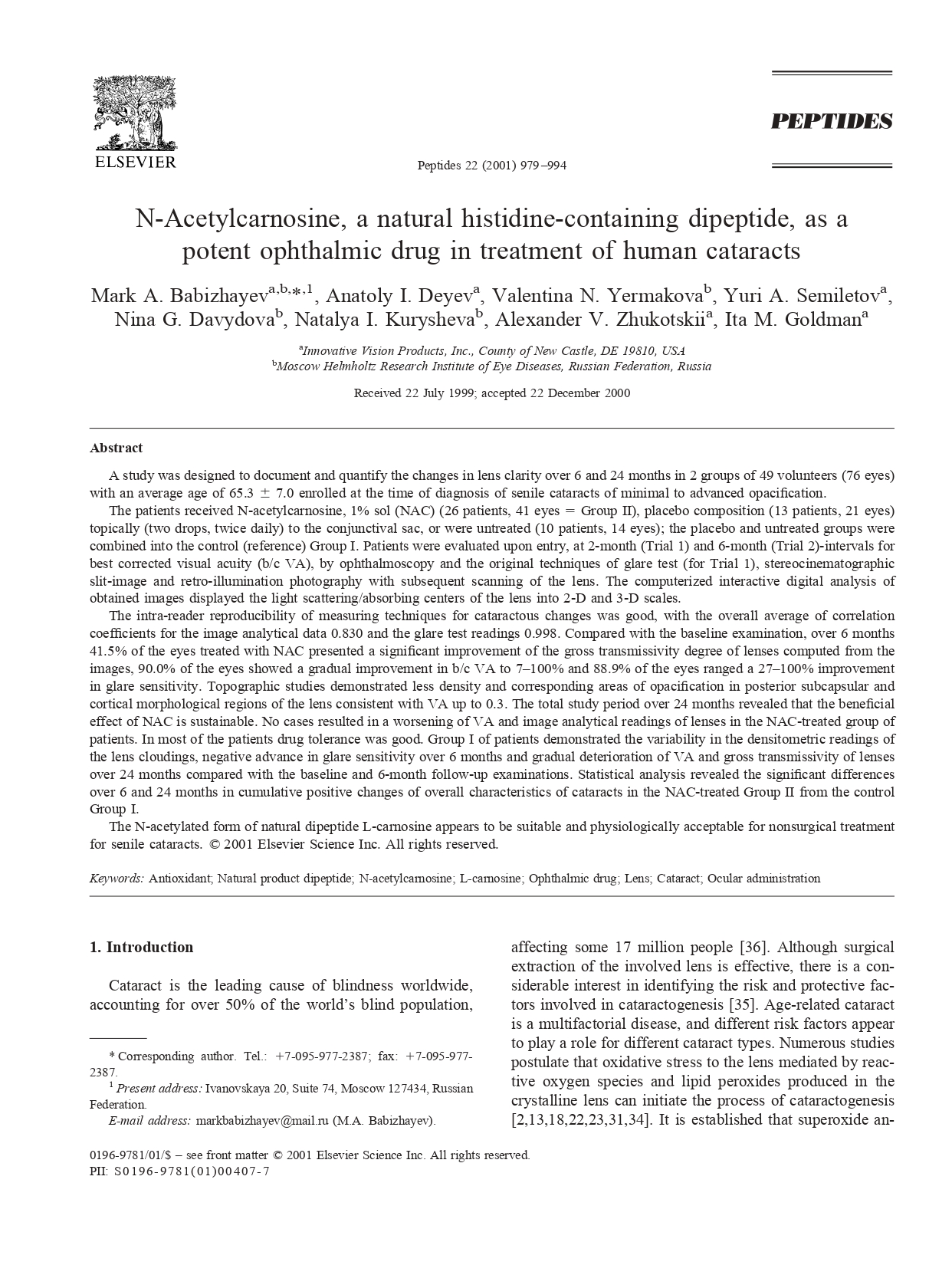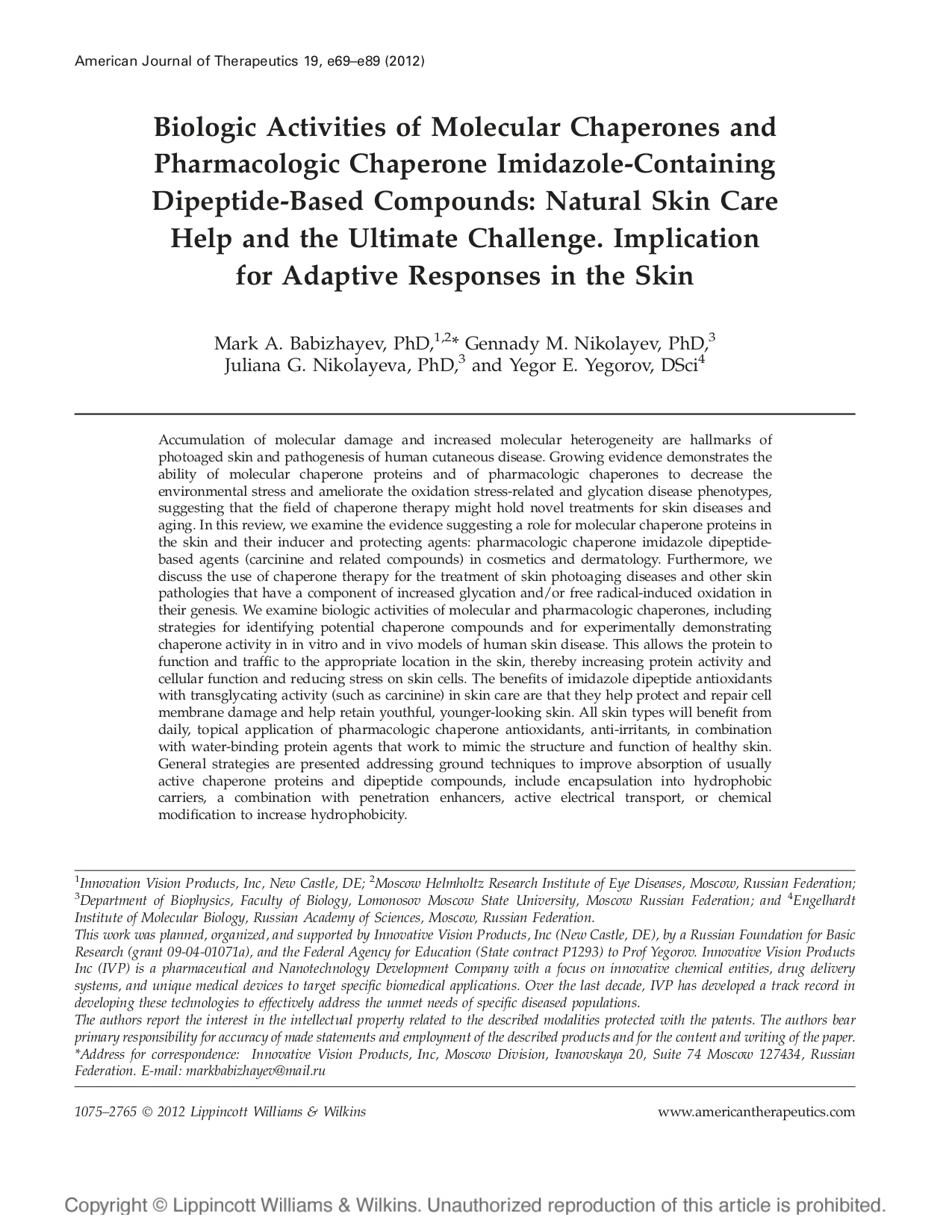Publications and Articles
Novel Neuroendocrine and Metabolic Mechanism Provides the Patented Platform for Important Rejuvenation Therapies: Targeted Therapy of Telomere Attrition and Lifestyle Changes of Telomerase Activity with the Timing of Neuron-Specific Imidazole-Containing Dipeptide-Dominant Pharmaconutrition Provision
Telomere length is emerging as a biomarker for aging and survival is paternally inherited and associated with parental lifespan. Telomere-associated cellular senescence may contribute to certain age-related disorders, including an increase in cancer incidence, wrinkling and diminished skin elasticity, atherosclerosis, osteoporosis, weight loss, age-related cataract, glaucoma and others. Shorter telomere length in leukocytes was associated cross-sectionally with cardiovascular disorders and its risk factors, including pulse pressure and vascular aging, obesity, vascular dementia, diabetes, coronary artery disease, myocardial infarction (although not in all studies), cellular turnover and exposure to oxidative and inflammatory damage in chronic obstructive pulmonary disease. Effective regulation of abnormal therapeutic targets of an age-related disease requires the alteration of either the topological structure or dynamic characteristics of telomeres which are DNA-protein structures at the ends of eukaryotic chromosomes, the DNA of which comprise noncoding repeats of guanine-rich sequences. Telomeric DNA plays a fundamental role in protecting the cell from recombination and degradation, including those as the metabolic super-achievers in the body, organ systems in a given target network of a disease and aging. In order to manage and control the complex direct and indirect target hubs, in this paper, a review of the recent patents is made analyzing techniques, new approaches developed during the last years in adaptive pharmacology directed at slowing and preventing the loss of telomere length that may slow aging using pharmaceutical and nutritional module-based designs, such as with regard to the timing of administration of imidazole-containing dipeptides. We discuss our recent identification of the role of neuron-specific imidazole-containing dipeptide based compounds (L-carnosine, N-acetylcarnosine, carcinine) that regulate and therapeutically control telomere shortening, telomerase activity and cellular senescence. We support a therapeutic concept of using nonhydrolyzed forms of naturally occurring imidazole-dipeptide based compounds carnosine and carcinine, making it clinically possible that slowing down the rate of telomere shortening could slow down the human aging process in specific tissues where proliferative senescence is known to occur with the demonstrated evidence of telomere shortening appeared to be a hallmark of oxidative stress and disease. The preliminary longitudinal studies of elderly individuals suggest that longer telomeres are associated with better survival and an advanced oral pharmaconutrition provision with non-hydrolyzed carnosine (or carcinine and patented compositions thereof) is a useful therapeutic tool of a critical telomere length maintenance (allowing indirectly to manipulate with telomerase activity) that may fundamentally be applied in the therapeutic treatment of agerelated sight-threatening eye disorders, Diabetes mellitus, sarcopenia (that is the gradual loss of muscle mass) that can affect elderly people and subjects under the effect of exhausting exercises and physical load, prolong life expectancy, increase survival and chronological age of an organism in health control, smoking behavior, metabolic syndrome increasing the risk of developing cardio-vascular diseases, age-related neurodegenerative diseases, including Alzheimer's disease and cognitive impairment.
Hormone-brain-aging relationships, broadly reactive with imidazole-containing dipeptides: targeting of telomere attrition as an aging biomarker and dynamic telomerase activity flirting
It has been documented that telomere-associated cellular senescence may contribute to certain age-related disorders, and telomere length may be an informative biomarker of healthy aging. Hormone-brain-aging behavior-modulated telomere dynamics and changes in telomerase activity are consistent elements of cellular alterations associated with changes in proliferative state, and these processes are consequently considered as the new therapeutic drug targets for physiological control with advanced drug delivery and nutritional formulations. We raise and support a therapeutic concept of using nonhydrolyzed forms of naturally occurring neuron-specific imidazole dipeptide-based compounds carnosine and carcinine, making it clinically possible that slowing down the rate of telomere shortening could slow down the human aging process in specific tissues where proliferative senescence is known to occur, with the demonstrated evidence of telomere shortening that appeared to be a hallmark of oxidative stress and disease. Carnosine released from skeletal from skeketal muscle during exercise may be transported into the hypothalamic tuberomammillary nucleus histamine neurons and hydrolyzed. The resulting L-histidine may subsequently be converted into histamine, which could be responsible for the effects of carnosine on neurotransmission and hormone-like antiaging physiological function. The preliminary longitudinal studies of elderly individuals suggest that longer telomeres are associated with better survival, and an advanced oral nutritional support with nonhydrolyzed carnosine (or carcinine and patented compositions thereof) is a useful therapeutic tool for a critical telomere length maintenance that may fundamentally be applied in the treatment of age-related sight-threatening eye disorders, prolonged life expectancy, increased survival and chronological age of organism in health control, smoking behavior, and disease.
An “Enigmatic” L-Carnosine (β-Alanyl-L-Histidine)? Cell Proliferative Activity as a Fundamental Property of a Natural Dipeptide Inherent to Traditional Antioxidant, Anti-Aging Biological Activities: Balancing and a Hormonally Correct Agent, Novel Patented Oral Therapy Dosage Formulation for Mobility, Skeletal Muscle Power and Functional Performance, Hypothalamic-Pituitary- Brain Relationship in Health, Aging and Stress Studies
Hypothalamic releasing and inhibiting hormones are major neuroendocrine regulators of human body metabolism being driven directly to the anterior pituitary gland via hypothalamic-hypophyseal portal veins. The alternative physiological or therapeutic interventions utilizing the pharmaco-nutritional boost of imidazole-containing dipeptides (non-hydrolized oral form of carnosine, carcinine, N-acetylcarnosine lubricant eye drops) can maintain health, enhance physical exercise performance and prevent ageing. Carnosine (β-alanyl-L-histidine) is synthesized in mammalian skeletal muscle. There is an evidence that the release of carnosine from the skeletal muscle sarcomeres moieties during physical exercise affects autonomic neurotransmission and physiological functions. Carnosine released from skeletal muscle during exercise acts as a powerful afferent physiological signaling stimulus for hypothalamus, may be transported into the hypothalamic tuberomammillary nucleus (TMN), specifically to TMN-histamine neurons and hydrolyzed herewith via activities of carnosine-degrading enzyme (carnosinase 2) localized in situ. Through the colocalized enzymatic activity of Histidine decarboxylase in the histaminergic neurons, the resulting L-histidine may subsequently be converted into histamine, which could be responsible for the effects of carnosine on neurotransmission and physiological function. Carnosine and its imidazole-containing dipeptide derivatives are renowned for their anti-aging, antioxidant, membrane protective, metal ion chelating, buffering, anti-glycation/transglycating activities used to prevent and treat a spectrum of age-related and metabolic diseases, such as neurodegenerative disease, sight threatening eye diseases, Diabetes mellitus and its complications, cancers and other disorders due to their wide spectrum biological activities. The precursor of carnosine (and related imidazole containing compounds) synthesis in skeletal muscles beta-alanine is used as the oral supplement by athletes to achieve the fine sporting art results due to the buffering activities of carnosine and its related imidazole-containing compounds which contribute to the maintenance of the acid-base balance in the acting muscles. This work originally emphasizes that overall data indicate the signaling activities of carnosine in skeletal and cardiac muscles switching on the mechanisms of exercise-induced telomere protection and point to the stress response and growth/cellular proliferation pathways as high-priority candidates for the ongoing studies and therapeutic concepts. The therapeutic interventions utilizing the specific oral formulation, timing dosing and pharmaco-nutritional boost of imidazole- containing dipeptides can maintain health, enhance physical exercise performance and prevent aging. The patented therapeutic concept protects the existence of the interesting physiological major activities, better controls and therapeutic treatments for aging/age-related disorders (including age-related loss of muscle mass and muscle function) using carnosine dipeptide for cellular rejuvenation and manipulating telomeres and enzyme telomerase activity that may reduce some of the physiological declines that accompany agingFailure to withstand oxidative stress induced by phospholipid hydroperoxides as a possible cause of the lens opacities in systemic diseases and ageing
Generation of reactive oxygen species in the anterior eye segment. Synergistic codrugs of N-acetylcarnosine lubricant eye drops and mitochondria-targeted antioxidant act as a powerful therapeutic platform for the treatment of cataracts and primary open-angle glaucoma
Senile cataract is a clouding of the lens in the aging eye leading to a decrease in vision. Symptoms may include faded colors, blurry vision, halos around light, trouble with bright lights, and trouble seeing at night. This may result in trouble driving, reading, or recognizing faces. Cataracts are the cause of half of blindness and 33% of visual impairment worldwide. Cataracts result from the deposition of aggregated proteins in the eye lens and lens fiber cells plasma membrane damage which causes clouding of the lens, light scattering, and obstruction of vision. ROS induced damage in the lens cell may consist of oxidation of proteins, DNA damage and/or lipid peroxidation, all of which have been implicated in cataractogenesis. The inner eye pressure (also called intraocular pressure or IOP) rises because the correct amount of fluid can't drain out of the eye. With primary open-angle glaucoma, the entrances to the drainage canals are clear and should be working correctly. The clogging problem occurs further inside the drainage canals, similar to a clogged pipe below the drain in a sink. The excessive oxidative damage is a major factor of the ocular diseases because the mitochondrial respiratory chain in mitochondria of the vital cells is a significant source of the damaging reactive oxygen species superoxide and hydrogen peroxide. However, despite the clinical importance of mitochondrial oxidative damage, antioxidants have been of limited therapeutic success. This may be because the antioxidants are not selectively taken up by mitochondria, but instead are dispersed throughout the body, ocular tissues and fluids' moieties. This work is an attempt to integrate how mitochondrial reactive oxygen species (ROS) are altered in the aging eye, along with those protective and repair therapeutic systems believed to regulate ROS levels in ocular tissues and how damage to these systems contributes to age-onset eye disease and cataract formation. Mitochondria-targeted antioxidants might be used to effectively prevent ROS-induced oxidation of lipids and proteins in the inner mitochondrial membrane in vivo. The authors developed and patented the new ophthalmic compositions including N-acetylcarnosine acting as a prodrug of naturally targeted to mitochondria L-carnosine endowed with pluripotent antioxidant activities, combined with mitochondria-targeted rechargeable antioxidant (either MitoVit E, Mito Q or SkQs) as a potent medicine to treat ocular diseases. Such specificity is explained by the fact that developed compositions might be used to effectively prevent ROS-induced oxidation of lipids and proteins in the inner mitochondrial membrane in vivo and outside mitochondria in the cellular and tissue structures of the lens and eye compartments. Mitochondrial targeting of compounds with universal types of antioxidant activity represents a promising approach for treating a number of ROS-related ocular diseases of the aging eye and can be implicated in the management of cataracts and primary open-angle glaucoma.
Management of the Virulent Influenza Virus Infection by Oral Formulation of Nonhydrolized Carnosine and Isopeptide of Carnosine Attenuating Proinflammatory Cytokine-Induced Nitric Oxide Production
Inducible nitric oxide synthase (iNOS) plays an important role in mediating inflammation. In our studies, we found that iNOS-derived NO was significantly increased in the serum samples of 150 patients infected with influenza A virus in comparison with samples of 140 healthy individuals. In human lung epithelial cells, infection with influenza A virus or stimulation with poly(I:C) + interferon-gamma resulted in increased mRNA and protein levels of both interleukin-32 and iNOS, with subsequent release of NO. Activated macrophages are also a source of nitric oxide (NO), which is largely produced by iNOS in response to proinflammatory cytokines. In this review article, the presented findings have many important implications for understanding the Influenza A (H1N1) viral pathogenesis, prevention, and treatment. The direct viral cytotoxicity (referred cytopathic effect) is only a fraction of several types of events induced by virus infection. Nitric oxide and oxygen free radicals such as superoxide anion (O2·-) are generated markedly in influenza A (including H1N1) virus–infected host boosts, and these molecular species are identified as the potent pathogenic agents. The mutual interaction of NO with O2·-· resulting in formation of peroxynitrite is operative in the pathogenic mechanism of influenza virus pneumonia. The toxicity and reactivity of oxygen radicals, generated in excessive amounts mediate the overreaction of the host’s immune response against the organs or tissues in which viruses are replicating, and this may explain the mechanism of tissue injuries observed in influenza virus infection of various types. The authors revealed the protection that carnosine and its bioavailable nonhydrolized forms provide against peroxynitrite damage and other types of viral injuries in which immunologic interactions are usually involved. Carnosine (beta-alanyl-L-histidine) shows the pharmacologic intracellular correction of NO release which might be one of the important factors of natural immunity in controlling the initial stages of influenza A virus infection (inhibition of virus replication) and virus-induced regulation of cytokine gene expression. The protective effects of orally applied nonhydrolized formulated species of carnosine include at least direct interaction with nitric oxide, inhibition of cytotoxic NO-induced proinflammatory condition, and attenuation of the effects of cytokines and chemokines that can exert profound effects on inflammatory cells. These data are consistent with the hypothesis that natural products, such as chicken soup and chicken breast extracts rich in carnosine and its derivative anserine (beta-alanyl-1-methyl-L-histidine) could contribute to the pathogenesis and prevention of influenza virus infections and cold but have a limitation due to susceptibility to enzymatic hydrolysis of dipeptides with serum carnosinase and urine excretion after oral ingestion of a commercial chicken extract. The developed and patented by the authors formulations of nonhydrolized in digestive tract and blood natural carnosine peptide and isopeptide (gamma-glutamyl-carnosine) products have a promise in the Influenza A (H1N1) virus infection disease control and prevention.
Coated with Nanomaterials Intraocular Lenses, Ophthalmic and Human Body Implantable Devices with High Catalytic Antioxidant Activities: A New Nanotechnology Strategy of Peroxidase Cellular Enzyme Mimics Increasing the Biocompatibility and Therapeutic Deployment of the Medical Prosthetic Device
While cataract surgery is generally recognized as being one of the safest operations, there is still a significant complication rate. From 30 to 50% of all patients in the United States having cataract extraction develop opacification of the posterior lens capsule within two years and require laser treatment with its own significant risk of complications. Of the patients having cataract surgery, 0.8% develop retinal detachments, from 0.6% to 1.3% were rehospitalized for corneal edema or required corneal transplantation and about 0.1% presented with endophthalmitis. Thus, aside from secondary cataract, about 2% of 1.3 million people, or 26,000 individuals in the United States annually develop serious complications as a result of cataract surgery.
The aim of this investigation was to increase the safety and effectiveness of an individual intraocular lens (IOL) preventing an impairment in peroxide metabolism of the mature human cataractous lenses compared to normal lenses employing the specific nanotechnology coating which substitutes the inhibitory effect of the implantable device towards the active species of oxygen and the ability of IOL to regulate the H2O2 and lipid hydroperoxides levels in the surrounding medium. The implantation of IOLs with metabolic activity improves the capability of the surrounding ocular tissues to withstand oxidative stress induced in ocular humors by the photochemical and other metabolic reactions. The coated implantable medical device with thin film of platinum applied with magnetron sputtering, reacts as a body enzyme with deleterious peroxide compounds and free radical oxygen species in body fluids and tissue when said device is implanted into human body. The IOL having haptics coated with thin film of platinum, catalyzes the reduction of peroxide compounds to decrease their levels within the aqueous humor. Further, the coatings also scavenge toxic free radicals of oxygen, thus preventing cellular dysfunction resulting from oxidative attack. Coated IOLs according to the patented nanotechnology can address the vast majority of cataract surgery-induced complications, such as secondary cataract, intraocular inflammation (endophthalmitis) and foreign body reactions, cystoid macular oedema, corneal edema. The nanotechnology offers physicians and surgeons to develop and commercialize cost- effective therapeutic medical implantable devices, products and support systems with metabolic activities for the treatment of ophthalmic diseases and of a wide range of pathological states and disorders which are treated by insertion of the implantable and prosthetic (polymeric) devices.
The aim of this investigation was to increase the safety and effectiveness of an individual intraocular lens (IOL) preventing an impairment in peroxide metabolism of the mature human cataractous lenses compared to normal lenses employing the specific nanotechnology coating which substitutes the inhibitory effect of the implantable device towards the active species of oxygen and the ability of IOL to regulate the H2O2 and lipid hydroperoxides levels in the surrounding medium. The implantation of IOLs with metabolic activity improves the capability of the surrounding ocular tissues to withstand oxidative stress induced in ocular humors by the photochemical and other metabolic reactions. The coated implantable medical device with thin film of platinum applied with magnetron sputtering, reacts as a body enzyme with deleterious peroxide compounds and free radical oxygen species in body fluids and tissue when said device is implanted into human body. The IOL having haptics coated with thin film of platinum, catalyzes the reduction of peroxide compounds to decrease their levels within the aqueous humor. Further, the coatings also scavenge toxic free radicals of oxygen, thus preventing cellular dysfunction resulting from oxidative attack. Coated IOLs according to the patented nanotechnology can address the vast majority of cataract surgery-induced complications, such as secondary cataract, intraocular inflammation (endophthalmitis) and foreign body reactions, cystoid macular oedema, corneal edema. The nanotechnology offers physicians and surgeons to develop and commercialize cost- effective therapeutic medical implantable devices, products and support systems with metabolic activities for the treatment of ophthalmic diseases and of a wide range of pathological states and disorders which are treated by insertion of the implantable and prosthetic (polymeric) devices.
A survey and analysis of the role of molecular chaperone proteins and imidazole-containing dipeptide-based compounds as molecular escorts into the skin during stress, injury, water structuring and other types of cutaneous pathophysiology
Molecular chaperone, heat shock proteins (HSPs), stabilizes intracellular processes of cells under stress. Little is known about the role of molecular chaperone proteins in the skin pathology, rejuvenation and wound healing, or whether their expression is altered by environmental and physiological stress to the skin or systemic disease. The focus of this study was to examine the role of molecular chaperone proteins in the skin’s local response to wounding, skin ageing and a range of skin diseases. Free radicals, one form of insult, induce or contribute to adverse effects on the skin, including erythema, oedema, wrinkling, photoaging, inflammation, autoimmune reactions, hypersensitivity, keratinization abnormalities, preneoplastic lesions and skin cancer. A unified view of the molecular and cellular pathogenesis of the skin age-related pathology conditions has led to the search for molecular and chemical chaperones that can slow, arrest or revert disease progression. Specific alphacrystallin domains and pharmacological imidazole-containing dipeptide chaperone molecules are now emerging that link our biophysical insights with developed skin therapeutic techniques. In this article, we discuss the molecular nature of the stress signals, the mechanisms that underlie activation of the heat shock response, the role of molecular chaperone proteins as skin protective molecules, and strategies for pharmacologically active chaperone molecules and their imidazole-containing dipeptide inducers as regulators of the skin stress response. We discuss how impairment in protein hydration may cause ultrastructural, mechanical and biochemical changes in structural proteins in the aged skin. We have pioneered the molecular chaperone protein activated therapeutic or cosmetic platform to enable simultaneous analysis of water-binding and structuring characteristics for biology of skin ageing and skin disease-related pathways. This cutting-edge technology has improved the way that proteins hydrate in photoaged skin. The mechanisms of skin diseases, ageing, cellular, and signalling pathways mediated by targeting with molecular chaperone protein(s) in patented formulations with imidazole containing dipeptide (N-acetylcarnosine, carcinine, carnosine) are also discussed within this review.
Skin beautification with oral non-hydrolized versions of carnosine and carcinine: Effective therapeutic management and cosmetic skincare solutions against oxidative glycation and free-radical production as a causal mechanism of diabetic complications and skin aging
Advanced glycation Maillard reaction end products (AGEs) are causing the complications of diabetes and skin aging, primarily via adventitious and cross-linking of proteins. Long-lived proteins such as structural collagen are particularly implicated as pathogenic targets of AGE processes. The formation of α-dicarbonyl compounds represents an important step for crosslinking proteins in the glycation or Maillard reaction. The purpose of this study was to investigate the contribution of glycation coupled to the glycation free-radical oxidation reactions as markers of protein damage in the aging of skin tissue proteins and diabetes. To elucidate the mechanism for the cross-linking reaction, we studied the reaction between a three-carbon α-dicarbonyl compound, methylglyoxal, and amino acids using EPR spectroscopy, a spectrophotometric kinetic assay of superoxide anion production at the site of glycation and a chemiluminescence technique. The transglycating activity, inhibition of transition metal ions peroxidative catalysts, resistance to hydrolysis of carnosine mimetic peptide-based compounds with carnosinase and the protective effects of carnosine, carcinine and related compounds against the oxidative damage of proteins and lipid membranes were assessed in a number of biochemical and model systems. A 4-month randomized, double-blind, controlled study was undertaken including 42 subjects where the oral supplement of non-hydrolized carnosine was tested against placebo for 3 months followed by a 1-month supplement-free period for both groups to assess lasting effects. Assessment of the age-related skin parameters and oral treatment efficacy measurements included objective skin surface evaluation with Visioscan VC 98 and visual assessment of skin appearance parameters. The results together confirm that a direct one-electron transfer between a Schiff base methylglyoxal dialkylimine (or its protonated form) and methylglyoxal is responsible for the generation of the cross-linked radical cation and the radical counteranion of methylglyoxal. Under aerobic conditions, molecular oxygen can then accept an electron from the methylglyoxal anion to generate the superoxide radical anion causing the propagation of oxidative stress chain reactions in the presence of transition metal ions. Carnosine stabilized from enzymatic hydrolysis, carcinine and leucyl-histidylhydrazide in patented formulations thereof, demonstrate the Schiff bases’ transglycating activities concomitant with glycation site specific antioxidant activities and protection of proprietary antioxidant enzymes in the skin during aging and with diabetes lesions. During oral supplementation with stabilized from enzymatic hydrolysis carnosine, the skin parameters investigated showed a continuous and significant improvement in the active group during the 3 months of supplementation as compared to placebo. Visual investigation showed improvement of the overall skin appearance and a reduction of fine lines. No treatment-related side effects were reported. The finding that already-formed AGE cross-links can be pharmacologically severed and attendant pathology thereby reversed by non-hydrolized carnosine or carcinine in patented oral formulations thereof has broad implications for the skin beautification and therapeutics of the complications of diabetes and skin diseases associated with aging.
The detox strategy in smoking comprising nutraceutical formulas of non-hydrolyzed carnosine or carcinine used to protect human health
The increased oxidative stress in patients with smoking-associated disease, such as chronic obstructive pulmonary disease, is the result of an increased burden of inhaled oxidants as well as increased amounts of reactive oxygen species generated by various inflammatory, immune and epithelial cells of the airways. Nicotine sustains tobacco addiction, a major cause of disability and premature death. In addition to the neurochemical effects of nicotine, behavioural factors also affect the severity of nicotine withdrawal symptoms. For some peo ple, the feel, smell and sight of a cigarette and the ritual of obtaining, handling, lighting and smoking a cigarette are all associated with the pleasurable effects of smoking. For individuals who are motivated to quit smoking, a combination of pharmacotherapy and behavioural therapy has been shown to be most effective in controlling the symptoms of nicotine withdrawal. In the previous studies, we proposed the viability and versatility of the imidazole-containing dipeptide-based compounds in the nutritional compositions as the telomere protection targeted therapeutic system for smokers in combination with in vitro cellular culture techniques being an inves tigative tool to study telomere attrition in cells induced by cigarette smoke (CS) and smoke constituents. Our working therapeutic concept is that imidazole-containing dipeptide-based compounds (non-hydrolyzed carnosine and carcinine) can modulate the telomerase activity in the normal cells and can provide the redox regulation of the cellular function under the terms of environmental and oxidative stress and in this way protect the length and the structure of telomeres from attrition. The detoxifying system of non-hydrolyzed carnosine or carcinine can be applied in the therapeutic nutrition formulations or installed in the cigarette filter. Patented specific oral formulations of non-hydrolyzed carnosine and carcinine provide a powerful manipulation tool for targeted therapeutic inhibition of cumulative oxidative stress and inflammation and protection from telomere attrition associated with smoking. It is demonstrated in this work that both non-hydrolyzed carnosine and carcinine are characterized by greater bioavailability than pure L-carnosine subjected to enzymatic hydrolysis with carnosinase, and perform the detoxification of the a,b-unsaturated carbonyl compounds present in tobacco smoke. We argue that while an array of factors has shaped the history of the ‘safer’ cigaette, it is the current understanding of the industry’s past deceptions and continuing avoidance of the moral implications of the sale of products that cause the enormous suffering and death of millions that makes reconsideration of ‘safer’ cigarettes challenging. In contrast to this, the data presented in the article show that recommended oral forms of non-hydrolyzed carnosine and carcinine protect against CS-induced disease and inflammation, and synergistic agents with the actions of imidazole-containing dipeptide compounds in developed formulations may have therapeutic utility in inflammatory lung diseases where CS plays a role.
Non-hydrolyzed in digestive tract and blood natural L-carnosine peptide (“bioactivated Jewish penicillin”) as a panacea of tomorrow for various flu ailments: signaling activity attenuating nitric oxide (NO) production, cytostasis, and NO-dependent inhibition of influenza virus replication in macrophages in the human body infected with the virulent swine influenza A (H1N1) virus
Influenza (flu) is caused by a highly contagious virus that is spread by coughs and sneezes. Flu symptoms include high fever, chills and sweating, sore throat, weakness, headache, muscle and joint pains, and cough. Older people and those with an underlying medical condition are more likely to develop serious complications, including secondary bacterial pneumonia, primary influenza pneumonia, and inflammation of the brain or heart. There are three types of flu virus: A, B, and C. The flu virus has a unique ability to change its surface structure. This allows it to escape recognition by the body’s immune system and cause widespread illness (epidemics and pandemics). Most cases of influenza occur within a 6- to 8-week period during winter and spring. Epidemics occur when there are minor changes in the nature of the virus so that more people within a community are susceptible. Influenza A is more likely to cause epidemics. Pandemics (worldwide epidemics) occur when there are major changes in the virus so that the disease affects a large proportion of people in a geographic region or on more than one continent. The findings presented in this article have many important implications for understanding the influenza A (H1N1) viral pathogenesis, prevention, and treatment. Direct viral cytotoxicity (referred cytopathic effect) is only a fraction of several types of events induced by virus infection. Nitric oxide and oxygen free radicals such as superoxide anion (O-·) are generated markedly in influenza A (including H1N1) virus-infected host boosts, and these molecular species are identified as the potent pathogenic agents. The mutual interaction of nitric oxide (NO) with O-× resulting in the formation of peroxynitrite is operative in the pathogenic mechanism of influenza virus pneumonia. Influenza virus infection involves pathological events in which oxygen free radicals play an important role in the pathogenesis. The toxicity and reactivity of oxygen radicals generated in excessive amounts mediate the overreaction of the host’s immune response against the organs or tissues in which viruses are replicating, and this may explain the mechanism of tissue injuries observed in influenza virus infection of various types. In this article, the types of protection of carnosine in its bioavailable non- hydrolyzed forms in formulations are considered against reactive oxygen radical species-dependent injury, peroxynitrite damage, and other types of viral injuries in which impaired immune responses to viral pathogens are usually involved. Carnosine (b-alanyl-L-histidine) shows the pharmacological intracellular correction of NO release, which might be one of the important factors of natural immunity in controlling the initial stages of influenza A virus infection (inhibition of virus replication) and virusinduced regulation of cytokine gene expression. The protective effects of orally applied non-hydrolyzed formulated species of carnosine include at least the direct interaction with NO, inhibition of cytotoxic NO-induced proinflammatory condition, and attenuation of the effects of cytokines and chemokines that can exert profound effects on inflammatory cells. These data are consistent with the hypothesis that natural products, such as chicken soup and chicken breast extracts rich in carnosine and its derivative anserine (b-alanyl-1-methyl-L-histidine), could contribute to the pathogenesis and prevention of influenza virus infections and cold but have a limitation due to the susceptibility to enzymatic hydrolysis of dipeptides with serum carnosinase and urine excretion after oral ingestion of a commercial chicken extract. The formulations of non-hydrolyzed in digestive tract and blood natural carnosine peptide and isopeptide (g-glutamyl-carnosine) products, manufactured at the cGMP-certified facility and patented by the authors, have promise in the control and prevention of influenza A (H1N1) virus infection, cough, and cold.
Biological activities of the natural imidazole-containing peptidomimetics n-acetylcarnosine, carcinine and l-carnosine in ophthalmic and skin care products
Apart from genetically programmed cell aging, different external aggressors related to oxidative stress and lipid peroxidation (LPO) can accelerate the skin aging phenomenon. Oxidative stress associated with the formation of lipid peroxides is suggested to contribute to pathological processes in aging and systemic diseases known as the risk factors for cataract. Despite the fact that l-carnosine-related peptidomimetics N-acetylcarnosine (N-acetyl-h-alanyl-l-histidine) (NAC) and carcinine (h-alanylhistamine) are metabolically related to l-carnosine and have been demonstrated to occur in tissues of many vertebrates, including humans, these compounds were shown resistant toward enzymatic hydrolysis. A series of related biocompatible imidazole-containing peptidomimetics were synthesized in order to confer resistance to enzymatic hydrolysis and ex vivo improvement of protective antioxidative properties related to l-carnosine. The included findings revealed a greater role of N-acetylcarnosine (NAC) and carcinine ex vivo in the prolongation and potentiation of physiological responses to the therapeutical and cosmetics treatments with l-carnosine as antioxidant. 3-D molecular conformation studies proposed the antioxidant activity of peptidomimetics (carcinine, l-prolylhistamine, N-acetylcarnosine, l-carnosine) for metal ion binding, quenching of a number free radicals, and binding of hydroperoxide or aldehyde (including dialdehyde LPO products) in an imidazole-peroxide adducts. NAC can act as a time release (carrier) stable version of l-carnosine during application in ophthalmic pharmaceutical and cosmetics formulations which include lubricants. Carcinine, l- prolylhistamine show efficient deactivation of lipid hydroperoxides monitored by HPLC and protection of membrane phospholipids and water soluble proteins from the lipid peroxides-induced damages. This activity is superior over the lipophilic antioxidant vitamin E. The biologically significant applications of carnosine mimetics were patented by Dr. Babizhayev and the alliance Groups (WO 2004/028536 A1; WO 94/19325; WO 95/12581; WO 2004/064866 A1).
Lipid Peroxidation and Cataracts N-Acetylcarnosine as a Therapeutic Tool to Manage Age-Related Cataracts in Human and in Canine Eyes
Cataract formation represents a serious problem in the elderly, with approximately 25% of the population aged >65 years and about 50% aged >80 years experiencing a serious loss of vision as a result of this condition. Not only do cataracts diminish quality of life, they also impose a severe strain on global healthcare budgets. In the US, 43% of all visits to ophthalmologists by Medicare patients are associated with cataract. Surgery represents the standard treatment of this condition, and 1.35 million cataract operations are performed annually in the US, costing $US3.5 billion (year of costing, 1998). Unfortunately, the costs of surgical treatment and the fact that the number of patients exceeds surgical capacities result in many patients being blinded by cataracts worldwide. This situation is particularly serious in developing countries; worldwide 17 million people are blind because of cataract formation, and the problem will grow in parallel with aging of the population. In any event, surgical removal of cataracts may not represent the optimal solution. Although generally recognised as being one of the safest operations, there is a significant complication rate associated with this surgical procedure. Opacification of the posterior lens capsule occurs in 30–50% of patients within 2 years of cataract removal and requires laser treatment, a further 0.8% experience retinal detachments, approximately 1% are rehospitalised for corneal problems, and about 0.1% develop endophthalmitis. Although the risks are small, the large number of procedures performed means that 26 000 individuals develop serious complications as a result of cataract surgery annually in the US alone. Thus, risk and cost factors drive the investigation of pharmaceutical approaches to the maintenance of lens transparency. The role of free radical-induced lipid oxidation in the development of cataracts has been identified. Initial stages of cataract are characterised by the accumulation of primary (diene conjugates, cetodienes) lipid peroxidation (LPO) products, while in later stages there is a prevalence of LPO fluorescent end-products. A reliable increase in oxiproducts of fatty acyl content of lenticular lipids was shown by a direct gas chromatography technique producing fatty acid fluorine-substituted derivatives. The lens opacity degree correlates with the level of the LPO fluorescent end-product accumulation in its tissue, accompanied by sulfhydryl group oxidation of lens proteins due to a decrease of reduced glutathione concen tration in the lens. The injection of LPO products into the vitreous has been shown to induce cataract. It is concluded that peroxide damage of the lens fibre membranes may be the initial cause of cataract development. N-acetylcarnosine, has been found to be suitable for the nonsurgical prevention and treatment of age-related cataracts. This molecule protects the crystalline lens from oxidative stress-induced damage, and in a recent clinical trial it was shown to produce an effective, safe and long-term improvement in sight. When administered topically to the eye, N-acetylcarnosine functions as a time-release prodrug form of L-carnosine resistant to hydrolysis with carnosinase. N-acetylcarnosine has potential as an in vivo universal antioxidant because of its ability to protect against oxidative stress in the lipid phase of biological cellular membranes and in the aqueous environment by a gradual intraocular turnover into L-carnosine. In our study the clinical effects of a topical solution of N-acetylcarnosine on lens opacities were examined in patients with cataracts and in canines with age-related cataracts. These data showed that N-acetylcarnosine is effective in the management of age-related cataract reversal and prevention both in human and in canine eyes.
N-Acetylcarnosine, a natural histidine-containing dipeptide, as a potent ophthalmic drug in treatment of human cataracts
A study was designed to document and quantify the changes in lens clarity over 6 and 24 months in 2 groups of 49 volunteers (76 eyes) with an average age of 65.3 ± 7.0 enrolled at the time of diagnosis of senile cataracts of minimal to advanced opacification.
The patients received N-acetylcarnosine, 1% sol (NAC) (26 patients, 41 eyes = Group II), placebo composition (13 patients, 21 eyes) topically (two drops, twice daily) to the conjunctival sac, or were untreated (10 patients, 14 eyes); the placebo and untreated groups were combined into the control (reference) Group I. Patients were evaluated upon entry, at 2-month (Trial 1) and 6-month (Trial 2)-intervals for best corrected visual acuity (b/c VA), by ophthalmoscopy and the original techniques of glare test (for Trial 1), stereocinematographic slit-image and retro-illumination photography with subsequent scanning of the lens. The computerized interactive digital analysis of obtained images displayed the light scattering/absorbing centers of the lens into 2-D and 3-D scales.
The intra-reader reproducibility of measuring techniques for cataractous changes was good, with the overall average of correlation coefficients for the image analytical data 0.830 and the glare test readings 0.998. Compared with the baseline examination, over 6 months 41.5% of the eyes treated with NAC presented a significant improvement of the gross transmissivity degree of lenses computed from the images, 90.0% of the eyes showed a gradual improvement in b/c VA to 7–100% and 88.9% of the eyes ranged a 27–100% improvement in glare sensitivity. Topographic studies demonstrated less density and corresponding areas of opacification in posterior subcapsular and cortical morphological regions of the lens consistent with VA up to 0.3. The total study period over 24 months revealed that the beneficial effect of NAC is sustainable. No cases resulted in a worsening of VA and image analytical readings of lenses in the NAC-treated group of patients. In most of the patients drug tolerance was good. Group I of patients demonstrated the variability in the densitometric readings of the lens cloudings, negative advance in glare sensitivity over 6 months and gradual deterioration of VA and gross transmissivity of lenses over 24 months compared with the baseline and 6-month follow-up examinations. Statistical analysis revealed the significant differences over 6 and 24 months in cumulative positive changes of overall characteristics of cataracts in the NAC-treated Group II from the control Group I. The N-acetylated form of natural dipeptide L-carnosine appears to be suitable and physiologically acceptable for nonsurgical treatment for senile cataracts.
The patients received N-acetylcarnosine, 1% sol (NAC) (26 patients, 41 eyes = Group II), placebo composition (13 patients, 21 eyes) topically (two drops, twice daily) to the conjunctival sac, or were untreated (10 patients, 14 eyes); the placebo and untreated groups were combined into the control (reference) Group I. Patients were evaluated upon entry, at 2-month (Trial 1) and 6-month (Trial 2)-intervals for best corrected visual acuity (b/c VA), by ophthalmoscopy and the original techniques of glare test (for Trial 1), stereocinematographic slit-image and retro-illumination photography with subsequent scanning of the lens. The computerized interactive digital analysis of obtained images displayed the light scattering/absorbing centers of the lens into 2-D and 3-D scales.
The intra-reader reproducibility of measuring techniques for cataractous changes was good, with the overall average of correlation coefficients for the image analytical data 0.830 and the glare test readings 0.998. Compared with the baseline examination, over 6 months 41.5% of the eyes treated with NAC presented a significant improvement of the gross transmissivity degree of lenses computed from the images, 90.0% of the eyes showed a gradual improvement in b/c VA to 7–100% and 88.9% of the eyes ranged a 27–100% improvement in glare sensitivity. Topographic studies demonstrated less density and corresponding areas of opacification in posterior subcapsular and cortical morphological regions of the lens consistent with VA up to 0.3. The total study period over 24 months revealed that the beneficial effect of NAC is sustainable. No cases resulted in a worsening of VA and image analytical readings of lenses in the NAC-treated group of patients. In most of the patients drug tolerance was good. Group I of patients demonstrated the variability in the densitometric readings of the lens cloudings, negative advance in glare sensitivity over 6 months and gradual deterioration of VA and gross transmissivity of lenses over 24 months compared with the baseline and 6-month follow-up examinations. Statistical analysis revealed the significant differences over 6 and 24 months in cumulative positive changes of overall characteristics of cataracts in the NAC-treated Group II from the control Group I. The N-acetylated form of natural dipeptide L-carnosine appears to be suitable and physiologically acceptable for nonsurgical treatment for senile cataracts.
The Role of Oxidative Stress in Diabetic Neuropathy: Generation of Free Radical Species in the Glycation Reaction and Gene Polymorphisms Encoding Antioxidant Enzymes to Genetic Susceptibility to Diabetic Neuropathy in Population of Type I Diabetic Patients
Diabetic neuropathy represents the main cause of morbidity and mortality among diabetic patients. Clinical data support the conclusion that the severity of diabetic neuropathy is related to the frequency and duration of hyperglycemic periods. The presented experimental and clinical evidences propose that changes in cellular function resulting in oxidative stress act as a leading factor in the development and progression of diabetic neuropathy. Hyperglycemia – and dyslipidemia-driven oxidative stress is a major contributor, enhanced by advanced glycation end product (AGE) formation and polyol pathway activation. There are several polymorphous pathways that lead to oxidative stress in the peripheral nervous system in chronic hyperglycemia. This article demonstrates the origin of oxidative stress derived from glication reactions and genetic variations within the antioxidant genes which could be implicated in the pathogenesis of diabetic neuropathy. In the diabetic state, unchecked superoxide accumulation and resultant increases in polyol pathway activity, AGEs accumulation, protein kinase C activity, and hexosamine flux trigger a feed-forward system of progressive dysfunction. In nerve, this confluence of metabolic and vascular disturbances leads to impaired neural function and loss of neurotrophic support, and over the long term, can mediate apoptosis of neurons and Schwann cells, the glial cells of the peripheral nervous system. In this article, we consider AGE-mediated reactive oxygen species (ROS) generation as a pathogenesis factor in the development of diabetic neuropathy. It is likely that oxidative modification of proteins and other biomolecules might be the consequence of local generation of superoxide on the interaction of the residues of L-lysine (and probably other amino acids) with α-ketoaldehydes. This phenomenon of non-enzymatic superoxide generation might be an element of autocatalytic intensification of pathophysiological action of carbonyl stress. Glyoxal and methilglyoxal formed during metabolic pathway are detoxified by the glyoxalase system with reduced glutathione as co-factor. The concentration of reduced glutathione may be decreased by oxidative stress and by decreased in situ glutathione reductase activity in diabetes mellitus. Genetic variations within the antioxidant genes therefore could be implicated in the pathogenesis of diabetic neuropathy. In this work, the supporting data about the association between the −262T > C polymorphism of the catalase (CAT) gene and diabetic neuropathy were shown. The −262TT genotype of the CAT gene was significantly associated with higher erythrocyte catalase activity in blood of diabetic neuropathy patients compared to the −262CC genotype (17.8 ± 2.7 × 104 IU/g Hb vs. 13.5 ± 3.2 × 104 IU/g Hb, P = 0.0022). The role of these factors in the development of diabetic complications and the prospective prevention of diabetic neuropathy by supplementation in formulations of transglycating imidazole-containing peptide-based antioxidants (non-hydrolyzed carnosine, carcinine, n-acetilcarcinine) scavenging ROS in the glycation reaction, modifying the activity of enzymic and non-ennzymic antioxidant defenses that participate in metabolic processes with ability of controlling at transcriptional levels the differential expression of several genes encoding antioxidant enzymes inherent to diabetic neuropathy in Tipe I Diabetic patients, now deserve investigation.
Biologic Activities of Molecular Chaperones and Pharmacologic Chaperone Imidazole-Containing Dipeptide-Based Compounds: Natural Skin Care Help and Ultimate Challenge. Implication for Adaptive Responses in the Skin
Accumulation of molecular damage and increased molecular heterogeneity are hallmarks of photoaged skin and pathogenesis of human cutaneous disease. Growing evidence demonstrates the ability of molecular chaperone proteins and of pharmacologic chaperones to decrease the environmental stress and ameliorate the oxidation stress-related and glycation disease phenotypes, suggesting that the field of chaperone therapy might hold novel treatments for skin diseases and aging. In this review, we examine the evidence suggesting a role for molecular chaperone proteins in the skin and their inducer and protecting agents: pharmacologic chaperone imidazole dipeptide-based agents (carcinine and related compounds) in cosmetics and dermatology. Furthermore, we discuss the use of chaperone therapy for the treatment of skin photoaging diseases and other skin pathologies that have a component of increased glycation and/or free radical-induced oxidation in their genesis. We examine biologic activities of molecular and pharmacologic chaperones, including strategies for identifying potential chaperone compounds and for experimentally demonstrating chaperone activity in in vitro and in vivo models of human skin disease. This allows the protein to function and traffic to the appropriate location in the skin, thereby increasing protein activity and cellular function and reducing stress on skin cells. The benefits of imidazole dipeptide antioxidants with transglycating activity (such as carcinine) in skin care are that they help protect and repair cell membrane damage and help retain youthful, younger-looking skin. All skin types will benefit from daily, topical application of pharmacologic chaperone antioxidants, anti-irritants, in combination with water-binding protein agents that work to mimic the structure and function of healthy skin. General strategies are presented addressing ground techniques to improve absorption of usually active chaperone proteins and dipeptide compounds, include encapsulation into hydrophobic carriers, a combination with penetration enhancers, active electrical transport, or chemical modification to increase hydrophobicity.

